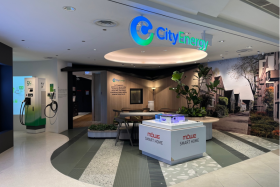More home fittings are water-efficient
PUB pilot test sees participants' water usage per month drop by 3 per cent
Watching ice melt around a polar bear might just prompt people to use less water when they are in the shower.
A pilot test by national water agency PUB showed that smart shower heads featuring the bear animation and which also digitally display real-time water usage helped people save 3 per cent on monthly water usage.
PUB hopes to expand the results of the six-month 2015 pilot scheme, which showed these smart shower heads helped 500 homes save 5 litres of water per person daily.
PUB will install the shower heads in 10,000 selected Housing Board Build-To-Order flats in the next couple of years.
This Smart Shower Programme is part of the agency's effort to reduce household water consumption.
Showering remains the largest source of water use in homes at 27 per cent, PUB said at a press conference yesterday, in connection with World Water Day on March 22, which is being marked in Singapore throughout the month.
It is followed by flushing, washing in the kitchen and laundry, based on a study of 400 households in 2016 and last year. Together, these activities form about three-quarters of household water usage.
A similar study in 2004 also showed showering was the top source of water use in homes at 29 per cent, slightly higher than the latest findings.
The recent study found that more than half of the water fittings in the key usage areas are efficient.
For example, 75 per cent of washing machines have a three-tick water-efficiency rating. This indicates that consumers are more aware of the need to install water-efficient models, said PUB.
The agency introduced the Mandatory Water Efficiency Labelling Scheme in 2009, which requires suppliers to display water efficiency ratings on appliances and fittings.
However, in the recent study, it was found that 35 per cent of kitchen sink taps were non-water-efficient, suggesting room for improvement in this area.
PUB said that while the recent study did not look into how much people save from using water-efficient fittings, statistics over the years have shown homes using less water.
Singapore's per capita household water consumption dropped from 165 litres per day in 2003 to 148 litres in 2016.
PUB said this could suggest that the use of water-efficient fittings and appliances has helped households save water, given the high adoption rate observed from the study.
The target is to lower consumption to 140 litres by 2030.
Professor Eduardo Araral, co-director of the Institute of Water Policy at the Lee Kuan Yew School of Public Policy, called the Smart Shower Programme very important, and is keen to know if the trial results will be reflected in daily use.
From April next year, PUB will be mandating the sale, supply and installation of at least two-tick water fittings in new homes, including private ones, as well as those undergoing renovation.
Non-water-efficient fittings and appliances - those that do not have at least a two-tick label - will be phased out.
Get The New Paper on your phone with the free TNP app. Download from the Apple App Store or Google Play Store now


